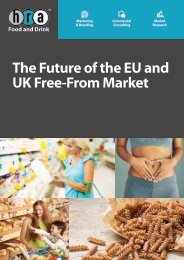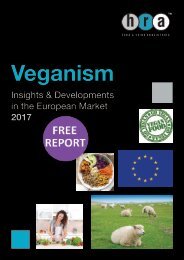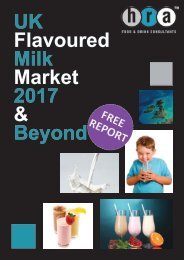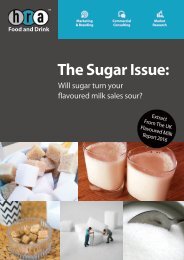FREE-UK-Flavoured-Milk-Report-2016-2017
The backdrop to the UK flavoured milk market is one of relentless change. The removal of the EU milk quotas, the transition to a Western-type diet by emerging economies, the UK sugar debate and the booming sports nutrition industry are all aspects of change that create both challenges and opportunities for the UK flavoured milk market. HRA Food and Drink Marketing has developed this report as a map to guide industry stakeholders. Although volume growth in 2014 was slightly lower than in previous years, the flavoured milk market still has plenty of room for product innovation and development. Overall, we expect the UK flavoured milk market to continue to grow over the medium term, but not without improving its nutritional profile. The sugar debate reached new heights when, in October 2015, Public Health England released a document suggesting Government intervention in the form of a sugar tax (levy). As a consequence, product reformulation has become a priority for all serious players in the market.
The backdrop to the UK flavoured milk market is one of relentless change. The removal of the EU milk quotas, the transition to a Western-type diet by emerging economies, the UK sugar debate and the booming sports nutrition industry are all aspects of change that create both challenges and
opportunities for the UK flavoured milk market.
HRA Food and Drink Marketing has developed this report as a map to guide industry stakeholders. Although volume growth in 2014 was slightly lower than in previous years, the flavoured milk market still has plenty of room for product innovation and development.
Overall, we expect the UK flavoured milk market to continue to grow over the medium term, but not without improving its nutritional profile. The sugar debate reached new heights when, in October 2015, Public Health England released a document suggesting Government intervention in the form of a sugar tax (levy). As a consequence, product reformulation has become a priority for all serious players in the market.
You also want an ePaper? Increase the reach of your titles
YUMPU automatically turns print PDFs into web optimized ePapers that Google loves.
<strong>UK</strong>#FLAVOURED#MILK#<strong>2016</strong>217#<br />
#<br />
It is also important to consider that GHG emissions allocated to agriculture<br />
do not account for transport or other associated emissions. As the <strong>UK</strong><br />
Government website states:<br />
“end-user emissions do not take account of the emissions ’embedded’ within<br />
the manufactured goods and services which the <strong>UK</strong> imports and exports.”<br />
That is, the agricultural sector emissions figure does not entirely reflect its<br />
true GHG emissions and is estimated to be higher than shown, including<br />
additional CO 2 emissions produced by trade and transport.<br />
The production on animal derived foods typically is associated with higher<br />
GHG emissions than plant based foods. A study by Scarborough et al. (2014)<br />
examined the differences in dietary GHG emissions between meat-eaters,<br />
fish-eaters, vegetarians and vegans in the <strong>UK</strong>. They found that GHG<br />
emissions of meat-eaters were around twice as high as those for vegans.<br />
With the Climate Change Act 2008 committing to at least at least an 80% cut<br />
in GHG emissions by 2050 compared to a 1990 baseline, it is important for<br />
the agricultural industry to address high GHG emissions. While there is a<br />
voluntary initiative for the industry (GHGAP) which focuses on the uptake of<br />
more resource efficient practices to lower emissions, there has been talk of a<br />
carbon tax for agriculture. This will add additional costs to production for<br />
flavoured milk brands and is something producers should be aware of.<br />
6.16 Potential EU Exit<br />
In order to leave the EU, the <strong>UK</strong> will have to negotiate an agreement with the<br />
EU defining conditions of withdrawal and its future relationship. As these<br />
conditions have not yet been set out, it is difficult to fairly weigh up the<br />
benefits and drawbacks of staying in the EU. However, we have done so<br />
based on what we do know.<br />
#<br />
With the upcoming EU referendum To Gain expected Access to happen by the end of <strong>2017</strong>,<br />
the question of how an exit from Purchase the EU will The affect Full their industry in particular<br />
is a question many want answered. According to the FDF, the EU is the main<br />
<strong>Report</strong> Now<br />
trade partner for the <strong>UK</strong> with 73% of the <strong>UK</strong>’s agri-food exports going to<br />
other EU states. However, for dairy products in particular, the EU is even<br />
more important with 90% of <strong>UK</strong> dairy exports in 2015 destined for within the<br />
EU and 8 of the top 10 dairy destinations within the EU. In addition, dairy<br />
imports into the <strong>UK</strong> are almost exclusively from the EU which accounts for<br />
99.4% of dairy imports. Therefore, the EU is a crucial trade partner for the<br />
<strong>UK</strong>, but this is particularly the case for dairy.<br />
© <strong>2016</strong> Teepee Limited. All Rights Reserved.<br />
165







